

10个Python Itertools,让你的代码如虎添翼
电子说
描述
Python的美丽在于它的简洁性。
不仅因为Python的语法优雅,还因为它有许多设计良好的内置模块,能够高效地实现常见功能。
itertools模块就是一个很好的例子,它为我们提供了许多强大的工具,可以在更短的代码中操作Python的可迭代对象。
用更少的代码实现更多的功能,这就是你可以从itertools模块中获得的好处。让我们从本文中了解一下。
1、itertools.product(): 避免嵌套循环的巧妙方法
当程序变得越来越复杂时,你可能需要编写嵌套循环。同时,你的Python代码将变得丑陋和难以阅读:
list_a = [1, 2020, 70]
list_b = [2, 4, 7, 2000]
list_c = [3, 70, 7]
for a in list_a:
for b in list_b:
for c in list_c:
if a + b + c == 2077:
print(a, b, c)
# 70 2000 7
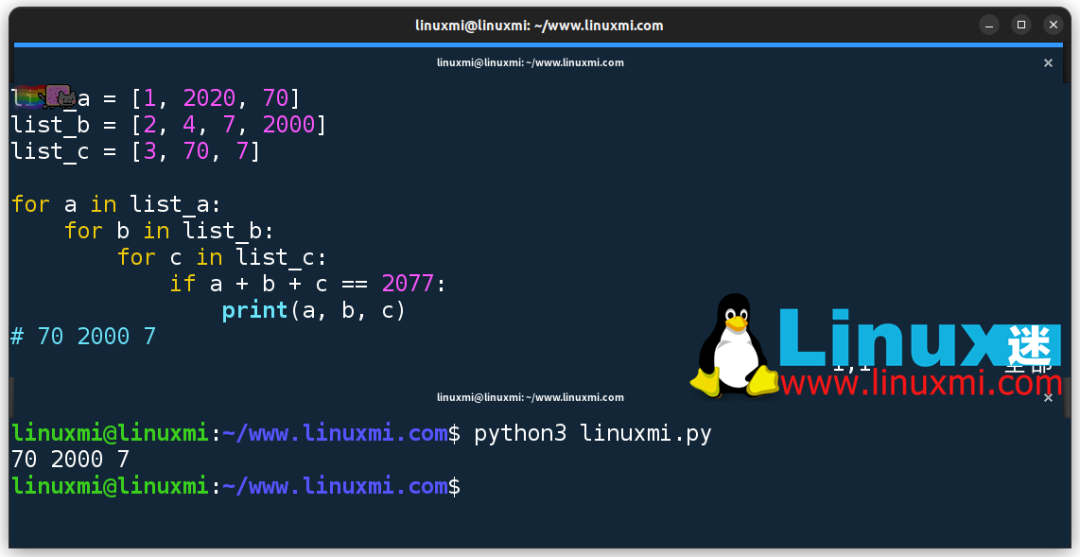
如何使上述代码再次具有 Python 风格?
那 itertools.product() 函数就是你的朋友:
from itertools import product
list_a = [1, 2020, 70]
list_b = [2, 4, 7, 2000]
list_c = [3, 70, 7]
for a, b, c in product(list_a, list_b, list_c):
if a + b + c == 2077:
print(a, b, c)
# 70 2000 7
如上所示,它返回输入可迭代对象的笛卡尔积,帮助我们将三个嵌套的for循环合并为一个。
2、itertools.compress(): 过滤数据的便捷方式
我们可以通过一个或多个循环来筛选列表中的项。
但有时候,我们可能不需要编写任何循环。因为有一个名为itertools.compress()的函数。
itertools.compress()函数返回一个迭代器,根据相应的布尔掩码对可迭代对象进行过滤。
例如,以下代码使用itertools.compress()函数选择出真正的领导者:
import itertools leaders = ['Yang', 'Elon', 'Tim', 'Tom', 'Mark'] selector = [1, 1, 0, 0, 0] print(list(itertools.compress(leaders, selector))) # ['Yang', 'Elon']
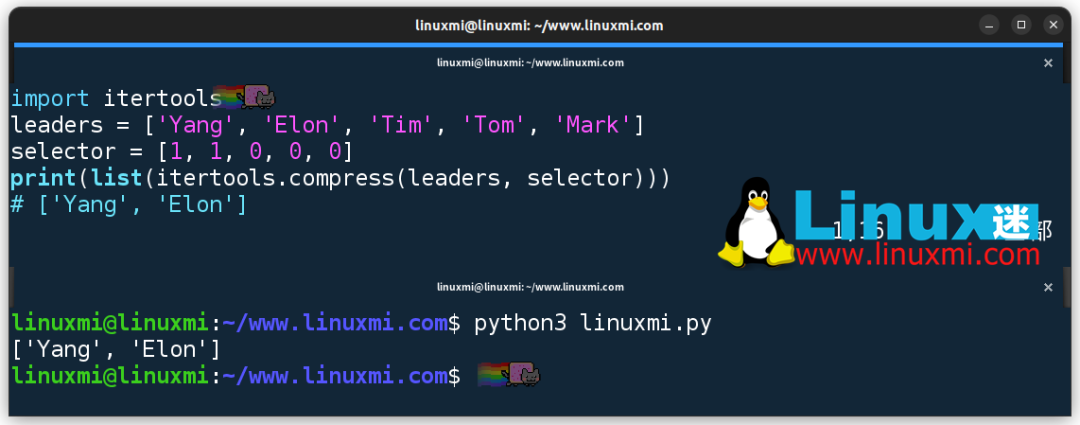
第二个参数selector作为掩码起作用,我们也可以这样定义它:
selector = [True, True, False, False, False]
3、itertools.groupby(): 对可迭代对象进行分组
itertools.groupby()函数是一种方便的方式,用于将可迭代对象中相邻的重复项进行分组。
例如,我们可以将一个长字符串进行分组,如下所示:
from itertools import groupby
for key, group in groupby('LinnuxmiMi'):
print(key, list(group))
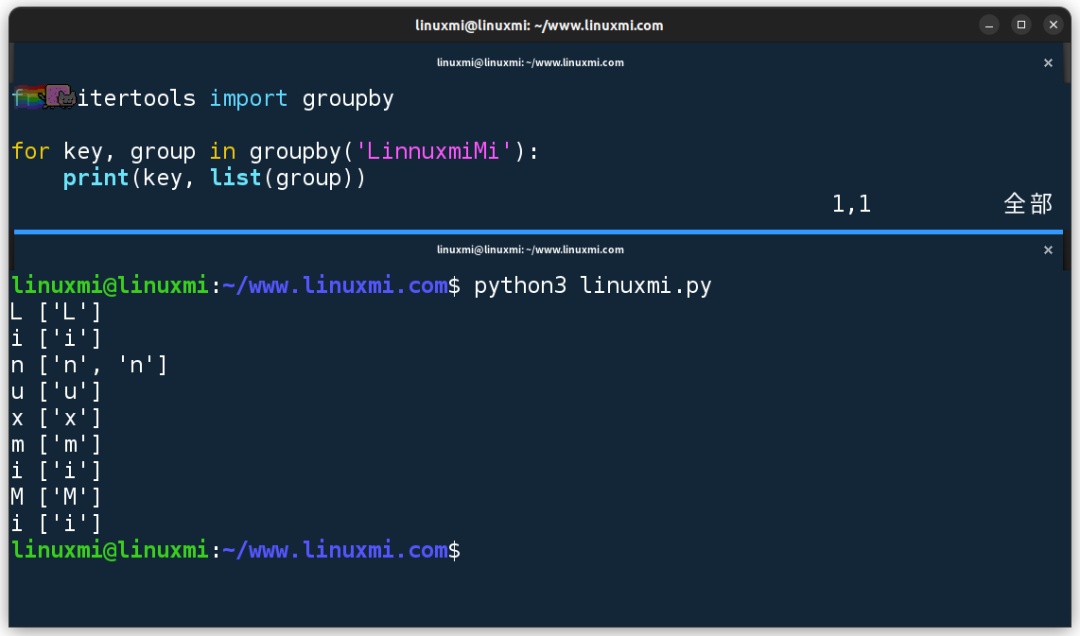
此外,我们可以利用它的第二个参数告诉groupby()函数如何确定两个项是否相同:
from itertools import groupby
for key, group in groupby('LinnuxmiMi', lambda x: x.upper()):
print(key, list(group))
4、itertools.combinations(): 从可迭代对象中获取给定长度的所有组合
对于初学者来说,编写一个无 bug 的函数来获取列表的所有可能组合可能需要一些时间。
事实上,如果她了解 itertools.combinations() 函数,她可以很容易地实现:
import itertools
author = ['L', 'i', 'n', 'u', 'x']
result = itertools.combinations(author, 2)
for a in result:
print(a)
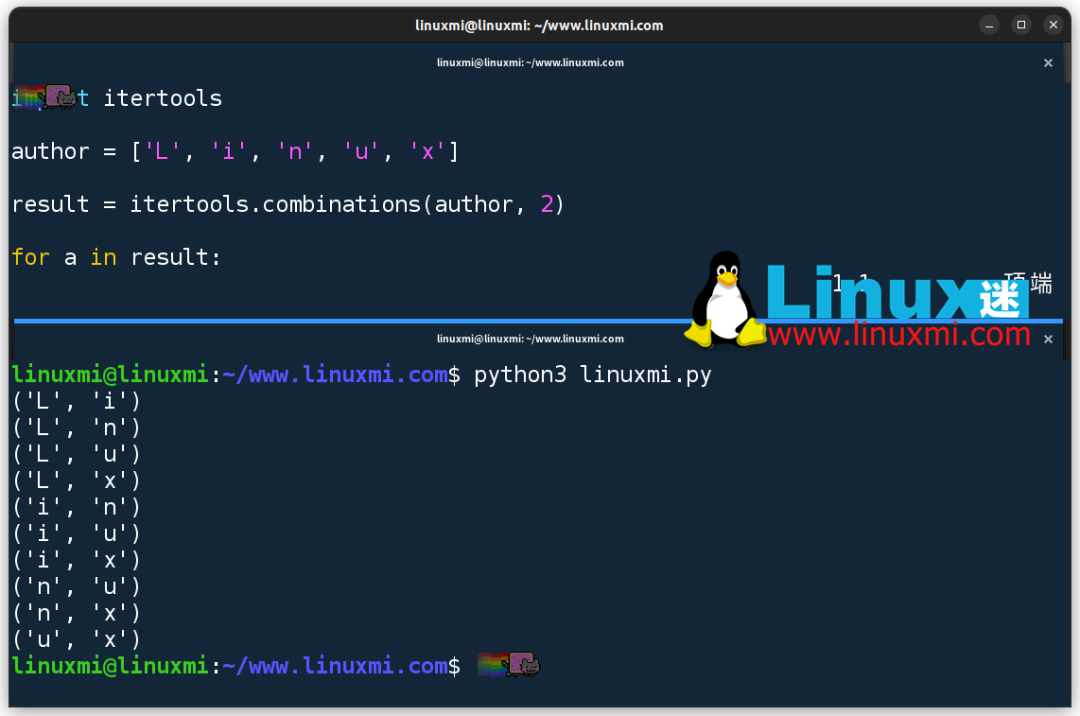
如上所示,itertools.combinations()函数有两个参数,一个是原始可迭代对象,另一个是函数生成的子序列的长度。
5、itertools.permutations(): 从可迭代对象中获取给定长度的所有排列
既然有一个函数可以获取所有组合,当然也有另一个名为itertools.permutations的函数来获取所有可能的排列:
import itertools
author = ['Y', 'a', 'n', 'g']
result = itertools.permutations(author, 2)
for x in result:
print(x)
# ('Y', 'a')
# ('Y', 'n')
# ('Y', 'g')
# ('a', 'Y')
# ('a', 'n')
# ('a', 'g')
# ('n', 'Y')
# ('n', 'a')
# ('n', 'g')
# ('g', 'Y')
# ('g', 'a')
# ('g', 'n')
如上所示,itertools.permutations()函数的用法与itertools.combinations()类似。唯一的区别在于它们的结果。
6、itertools.accumulate(): 从可迭代对象生成累积的项
基于可迭代对象获取一系列累积值是一种常见需求。借助itertools.accumulate()函数的帮助,我们无需编写任何循环即可实现。
import itertools import operator nums = [1, 2, 3, 4, 5] print(list(itertools.accumulate(nums, operator.mul))) # [1, 2, 6, 24, 120]如果我们不想使用operator.mul,上述程序可以改写如下:
import itertools nums = [1, 2, 3, 4, 5] print(list(itertools.accumulate(nums, lambda a, b: a * b))) # [1, 2, 6, 24, 120]
7、itertools.repeat(), itertools.cycle(), itertools.count(): 生成无限迭代对象
在某些情况下,我们需要获得无限迭代。有 3 个有用的功能:
itertools.repeat():重复生成相同的项
例如,我们可以得到三个相同的“Yang”,如下所示:
import itertools
print(list(itertools.repeat('Yang', 3)))
# ['Yang', 'Yang', 'Yang']
itertools.cycle(): 通过循环获得无限迭代器
itertools.cycle函数将不会停止,直到我们跳出循环:
import itertools
count = 0
for c in itertools.cycle('Yang'):
if count >= 12:
break
else:
print(c, end=',')
count += 1
# Y,a,n,g,Y,a,n,g,Y,a,n,g,
itertools.count(): 生成一个无限的数字序列 如果我们只需要数字,可以使用itertools.count函数:
import itertools
for i in itertools.count(0, 2):
if i == 20:
break
else:
print(i, end=" ")
# 0 2 4 6 8 10 12 14 16 18
如上所示,它的第一个参数是起始数字,第二个参数是步长。
8、itertools.pairwise(): 轻松获取成对的元组
自从Python 3.10版本开始,itertools模块新增了一个名为pairwise的函数。它是一个简洁而方便的工具,用于从可迭代对象中生成连续的重叠对。
import itertools
letters = ['a', 'b', 'c', 'd', 'e']
result = itertools.pairwise(letters)
print(list(result))
# [('a', 'b'), ('b', 'c'), ('c', 'd'), ('d', 'e')]
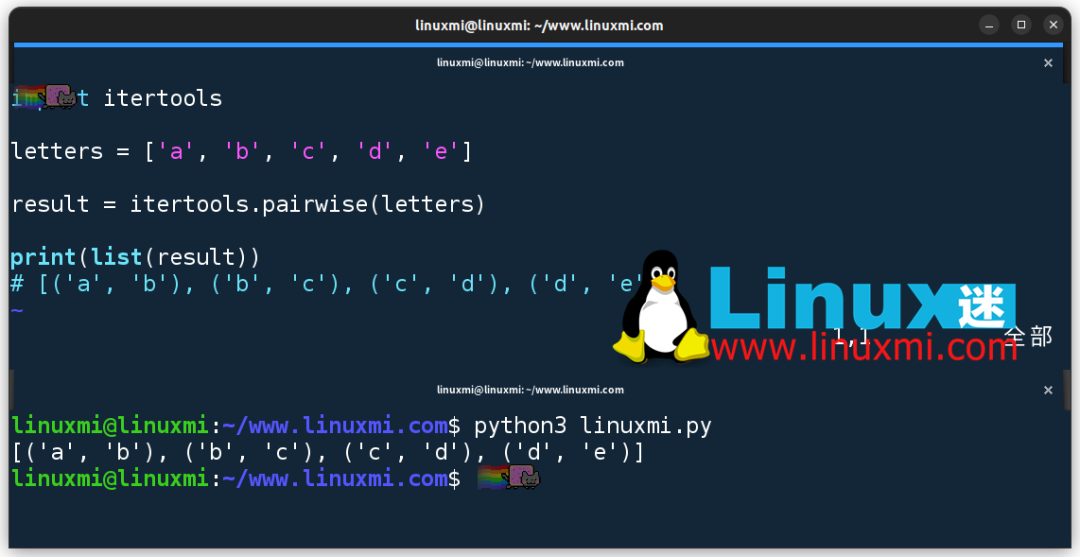
9、itertools.takewhile(): 以不同的方式过滤元素
itertools.takewhile()返回一个迭代器,只要给定的谓词函数评估为True,就会从可迭代对象中生成元素。
import itertools nums = [1, 61, 7, 9, 2077] print(list(itertools.takewhile(lambda x: x < 100, nums))) # [1, 61, 7, 9]该函数与内置的filter()函数不同。
filter函数将遍历整个列表:
nums = [1, 61, 7, 9, 2077] print(list(filter(lambda x: x < 10, nums))) # [1, 7, 9]然而,itertools.takewhile函数如其名称所示,当评估函数为False时会停止迭代:
import itertools nums = [1, 61, 7, 9, 2077] print(list(itertools.takewhile(lambda x: x < 10, nums))) # [1]
10、itertools.dropwhile(): itertools.takewhile的反向操作
这个函数似乎是前面那个函数的相反思路。
itertools.takewhile()函数在谓词函数为True时返回可迭代对象的元素,而itertools.dropwhile()函数在谓词函数为True时丢弃可迭代对象的元素,然后返回剩下的元素。
import itertools nums = [1, 61, 7, 9, 2077] print(list(itertools.dropwhile(lambda x: x < 100, nums))) # [2077]
审核编辑:汤梓红
-
10个杀手级的Python自动化脚本2022-11-28 951
-
Python面试必看的10个问题2018-02-28 4161
-
Labview与Python的网络编程2019-11-12 3839
-
10年Python功力,总结了10个开发技巧,非常实用2020-08-26 3397
-
让你的 Python 代码优雅又地道2018-03-06 3937
-
Python系统库itertools的详细资料介绍2018-06-18 3593
-
7个Python调试通过的代码详细资料分析2018-10-14 3813
-
Python 代码加速运行的的小技巧2021-09-01 2176
-
一些值得玩味的python代码2022-03-30 2209
-
10种聚类介绍和Python代码2022-07-30 7077
-
20个解决日常问题的Python代码片段!2023-03-13 1413
-
深度学习如何让Turing 显卡如虎添翼2023-08-01 1105
-
Yapf:一个格式化 Python 代码的好帮手2023-10-17 1598
-
python代码写完后点哪个运行2023-11-24 7552
-
python软件怎么运行代码2023-11-28 1864
全部0条评论

快来发表一下你的评论吧 !

